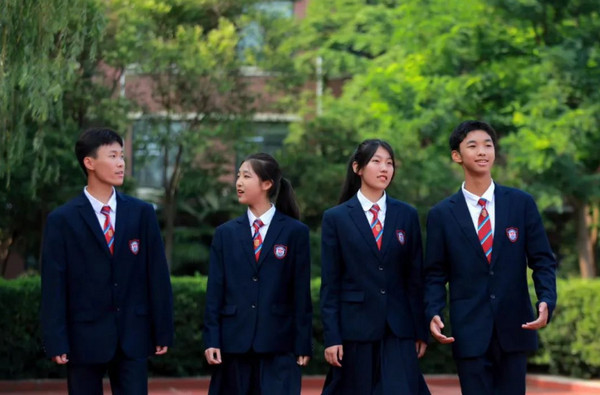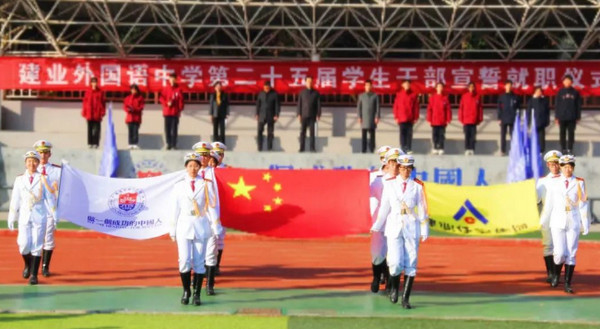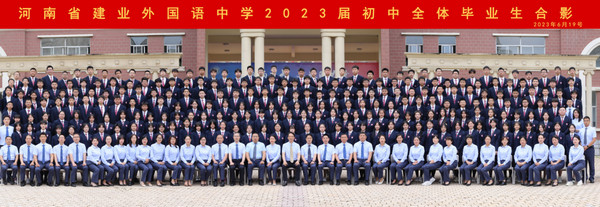1.培养目标与学术诚信 Learner profile and academic integrity
坚持原则——学生以诚实正直的态度尊重他人劳动成果,有强烈的公平感和正义感,尊重个人、集体和社区尊严。为自己的行为及后果负责。
Principled - students respect the fruits of others' labor with honesty and integrity, have a strong sense of fairness and justice, and respect for individual, collective and community dignity. Take responsibility for your actions and their consequences.
知识渊博——学生必须了解学术诚信,并付诸行动,确保所提交的作品都属原创。
Knowledgeable - students must understand academic integrity and take action to ensure that all submissions are original.
2.学校学术诚实理念 The philosophy of the school's academic integrity policy
国际文凭课程(IB)项目强调学术诚实,要求学习者严谨且有原则。在我们提问、探究和行动的学习过程中,我们重视诚实和学术诚信。我们激励全体师生,与责任同行。
The international baccalaureate (IB) program emphasizes academic honesty and requires rigorous and principled learners. In our learning process of questioning, inquiry, and action, we value honesty and academic integrity. We encourage all teachers and students to be honest and responsible.
我们相信学术和个人诚信教育是学生教育的基础部分。学术诚信是一系列促进个人诚信的价值观与能力,且能推进教育、学习和评估的实践。
We believe academic and personal integrity education is a fundamental part of student education. Academic integrity is a series of values and abilities that promote personal integrity and can promote the practice of education, learning, and evaluation.
3.学校学术诚信政策的目标 The goal of the school's academic integrity policy
建设和发扬学术诚信的校园文化。Building and promoting the campus culture of academic integrity.
确保全体学生、家长和教师理解何为学术诚信和原创作品。Ensuring that all students, parents, and teachers understand academic integrity and original writing.
确保全体学生接受学术写作和注明出处的技能指导。Ensure that all students receive instruction in academic writing and citation.
确保全体学生清楚不端行为的后果。Ensure that all students are aware of the consequences of misconduct.
4.政策实施Implementation of the policy
所有教师都有一份学术诚实政策。
所有教师都需要熟悉该政策。
每年开学初学生学习学术诚实政策。
家长需要了解学术诚实政策。
学校管理人员与教师每年需要修订学术诚实政策。
任何违反学术诚实的结果将由集体讨论决定。
All staff members will have one copy of the policy
All staff is familiar with the policy in the Professional Development sessions each year
The students will be shown and explained the policy at the beginning of every year
Parents will be shown the policy every year
The Senior Management Team together with the related staff will review the policy every year
Any behavior that breaches this policy will be paneled
5.学术诚实的定义 Understanding academic honesty
“学术诚实”是教育的指导原则,也是选择让其他人信任我们的负责任行为。它是合法、真实和诚实的学术作品完成过程中道德决策和行为的基础。“学术诚实”应被视为一系列价值观和有效的技能,它不但可以有效促进个人完整性的培养,也可以促进有效的教学、学习和评估等。“学术诚实”受到多方面因素的影响和塑形,包括同伴、文化、家长期望、角色示范和教学技能。
Academic integrity is a guiding principle in education and a choice to act in a responsible way whereby others can have trust in us as individuals. It is the foundation for ethical decision-making and behaviour in the production of legitimate, authentic and honest scholarly work2. Academic honesty must be seen as a set of values and skills that promote personal integrity and good practice in teaching, learning and assessment. It is influenced and shaped by a variety of factors including peer pressure, culture, parental expectations, role modelling and taught skills.
“学术诚实政策”旨在界定和澄清何为学术诚实,并明确我们对于我校学生在学术诚实方面的期望。为了让学习者社区所有成员都能够了解学术诚实,并清楚哪些行为可能导致违反学术诚实,我们对学术不端行为做了说明,舞弊被定义为导致或可能导致候选人或任何其他候选人在一个或多个评估部分获得不公平优势的行为。包括:
The academic integrity policy aims to define and clarify what is academic integrity, and to clarify our expectations of our students in terms of academic integrity. In order to allow all members of the learner community to understand academic integrity and know what behaviors may lead to violations of academic integrity.Malpractice is defined as behavior that results in, or may result in, the candidate or any other candidate gaining an unfair advantage in one or more assessment component. Malpractice includes:
剽窃: 有意或无意使用他人的想法观点、文字或作品而未经适当、清晰和明确的承认。除非另有说明和承认,否则使用翻译材料也被视为剽窃。
plagiarism: defined as the representation, intentionally or unwittingly, of the ideas, words or work of another person without proper, clear and explicit acknowledgment. The use of translated materials, unless indicated and acknowledged, is also considered plagiarism.
共谋:支持他人舞弊,或者允许自己的作品被别人抄袭或作为考试内容。
collusion: this is defined as supporting malpractice by another candidate, as in allowing one’s work to be copied or submitted for assessment by another
重复:同一作品用来参加不同的评估内容或用来满足拿文凭的要求。
duplication of work: this is defined as the presentation of the same work for different assessment components and/or diploma requirements
其他:任何使考生获得不公平的优势或影响另一位考生考试结果的行为(例如,把未经授权的材料带入考场等考试期间的不当行为等)
any other behaviour that gains an unfair advantage for a candidate or that affects the results of another candidate (for example, taking unauthorized material into an examination room, misconduct during an examination)
6.角色和职责 Roles and responsibilities
(1)校长职责 The principal responsibility
校长必须确保全体教职员工意识到规则的重要性,并精确遵循正确程序,鼓励学术诚实,以促进良好学术实践和校园文化,使全体学生:
The President must ensure that all faculty and staff are aware of the importance of the rules and follow precisely the right procedures to encourage academic integrity in order to promote the good academic practice and campus culture for all students:
a.了解学术诚信的构成:真实的作品以及知识产权。Understand the composition of academic integrity: authentic works and intellectual property rights.
b.获得有关研究技能、学术写作、研究方法及如何注明引用资源出处的指导。 Obtain guidance on research skills, academic writing, research methods, and how to specify sources for citation.
c.理解何为不端行为,尤其是剽窃、串通和一稿多投。Understand misconduct, especially plagiarism, collusion, and multiple submissions.
d.明白被发现不端行为的后果。Understand the consequences of being caught misbehaving.
e.人手一份政策并签署声明,保证所有上交评估材料均属原创作品。Each person has a policy and a signed statement ensuring that all materials submitted for evaluation are original works.
IB 协调员职责 The MYP coordinator responsibility
a.明确学术诚信、作品真实性和知识产权。To clarify academic integrity, the authenticity of works and intellectual property rights.
b.明确自己在调查学生作弊时的职责。Identify your role in investigating cheating.
c.明确作弊行为的定义及作弊行为的后果。Clarify the definition of cheating and the consequences of cheating.
d.营造鼓励学术诚实的校园文化氛围。Create a campus culture that encourages academic honesty.
e.在预防、发现和调查学生作弊行为的过程中,充分协助教师。Assist teachers in the prevention, detection, and investigation of student cheating.
(2)图书管理员职责 Librarian duties
图书管理员必须充分意识到剽窃和版权的问题。作为图书管理员,应致力于为学生提供各类研究指南:强调阅读和写作技能的;强调良好学术实践的;以及 强调不依赖网络资料,提供优秀书面作品的重要性。
Librarians must be fully aware of the problem of plagiarism and copyright. As a librarian, one should devote oneself to providing students with a variety of research guides: those that emphasize reading and writing skills; Emphasizing good academic practice; And emphasize the importance of providing excellently written works without relying on online materials.
(3)教师职责 The teachers responsibility
a.教师要争取任何机会,指导学生如何做才符合学术诚实的要求。Teachers should strive for an opportunity to instruct students how to do to meet the requirements of academic honesty.
b.教师要指导学生与学术诚实有关的专门技能。The teacher should guide the students with special skills related to academic honesty.
c.提供机会让学生展现如何实践学术诚实。Provide opportunities for students to demonstrate academic integrity.
d.以身作则,示范良好的学术诚实行为。Set an example of good academic honesty. 所有学科须执行学术诚信政策,这样学生才能清楚知道各学科对抄袭的定义。各 学科教师需向学生说明数据源、电脑程序、照片、图标、插图和地图等引用的要 求。Academic integrity policies should be implemented in all subjects so that students can clearly understand the definition of plagiarism. Subject teachers need to explain to students the requirements of references such as data sources, computer programs, photos, ICONS, illustrations, and maps.
(4)学生职责 The students’ responsibility
a.无论是做功课、评估时,都必须是自己完成,不抄袭。No matter the issue do homework, take evaluations, coursework must be done by oneself, and students do not copy.
b.使用正确格式引用信息,并在参考文献中全部列出。Cite information in the correct format and list it all in the references.
c.确保读者可以找到信息出处。Make sure the reader can find the source of the information;
d.任何时候都不能有任何形式的学术不诚信行为;包括抄袭,串通舞弊,重复提 交以及其他形式的欺骗行为。At no time should there be any form of academic dishonesty; This includes plagiarism, collusion, multiple submissions, and other forms of cheating.
e.学生要签署学术诚信保证书。Students should sign the academic integrity guarantee.
家长职责 The parents’ responsibility
a.以身作则,示范良好的学术诚实行为;配合学校的政策,确认及赞赏学生的学术诚实行为。Set an example of good academic honesty; To recognize and appreciate students' academic honesty in line with the school' s policy;
b.当学生进行学习时,为学生提供支持,使他们合法地取得需要的资源。Provide support to students as they proceed with their studies, enabling them to legally obtain the resources they need.
7.学术不端及其后果 Academic misconduct and consequences
|
|
学术不端Academic misconduct |
后果consequences |
|
学习过程中 Behavior in learning processes |
抄袭他人作品 把自己作品给他人抄袭 帮他人做作业 个人作品当做是一个小组的作品 伪造CAS活动记录 Copy work from other students Give their own work to be copied by other students Write homework for other students Individual work is reported to be a group work Work can’t be finished before deadlines Falsify CAS Records |
抄袭别人的作品,成绩记为0分 把自己作品给他人抄袭, 双方成绩记为0分 帮他人写作业, 该成绩记为0分 个人的作品当做是一个小组的作品,小组所有成员的成绩记为0分 伪造CAS活动记录,该CAS活动为不通过 If a student copies work from other students, his/her results will be zero If students give their own work to be copied by other students, both students will get zero If a student writes homework for other students, his/her results will be zero In case in group work, if individual work is reported to be a group work, all the students in this group will get zero Work can’t be finished before deadlines, the results will be degraded. If students falsify CAS Records, the DP application capability will be cancelled. |
|
考试期间 Durning exam |
使用不允许的笔记 抄袭他人答案 使用电子设备与考场内外的人交流 使用不被允许的词典、计算器或电子设备 偷窃试卷 Use notes during a test not Allowed by the examination rules Copy answers from another student Use electronics to communicate with anyone inside or outside the exam Use dictionaries, calculators and or electronic device unless allowed by the examination rules Stealing examination papers |
如果左边任一情况发生,考试成绩记为0分,根据情节轻重,决定处理结果。 If the event on the left occurs, the examination results will be zero and the students will be paneled depending on the seriousness. |
|
学生的作品中 In the students’ work |
如果使用或参考了他人资源,却未标明参考书目 虽然标明他人资源,但作品大部分内容是别人的观点 同一作品用来参加不同的评估内容或用来满足拿文凭的要求 伪造数据 Lack bibliography if other resources are used or referenced Acknowledged, but majority of work is other’s viewpoint Same work for different assessment components and/or diploma requirements Fabricating data for an assignment |
如果这种情况发生,学生将被要求标明参考书目 如果还有时间剩余,学生可以有机会修改作品 如果并无其他选择,成绩将作零分处理 If this happens, students will be required to add the lacking bibliography If there is time, students have an opportunity to revise the work If there is no other choice, the results will be zero |
|
违反与惩罚 Violation and punishment |
a.任何不诚信作品都将会受到惩罚,剽窃部分被判定为零分。Any dishonest work will be punished, plagiarism will be judged to be zero. b.严重的违反学术诚实的行为会被记入档案,并与家长进行面谈。(例如:捏造事实、欺骗、严重破坏他人作品等。)Serious violation of academic integrity will be documented and parents will be notified of any infractions. For example,fabrication, deception, sabotaging other student’s work. |
|
8.如何避免学术欺诈 How to avoid academic fraud
学生应当 The students should be
a.不仅用自己的话写,更为自己发声,使自己的作品独一无二。表达自己的观点,尽力提升作品的原创性。Write not only in your own words but also in your own voice, making your work unique. Express your opinion and try to improve the originality of the work.
b.懂得只要注明被引用观点的作者和出处,可以使用他人观点。Know that you can use other people's opinions as long as you note the author and source of the quoted opinion.
c.文内引用和参考文献上都要体现。It should be reflected in the references.
d.保持记录资料来源的良好习惯,符合APA引文指南。Maintain good practice of recording sources of information. This will be in compliance with APA citation guideline.
e.制定计划、合理安排,以防临时抱佛脚。Make plans and make reasonable arrangements in case you want to cram.
f. 学生将接受培训/课程,学习如何在学术期间引用论文的方法,符合APA标准。学生们会被教授如何写作与引用他人文章,有老师做专门的教授和辅导,以确保他们不会犯任何错误。Students will have training/classes on citing and sourcing material that they use within the academic periods in compliance with APA standards. The students will be given handouts about writing standards, and they are encouraged to speak with teachers to ensure that they don’t make any errors.
参考文献格式指南Citing and referencing guide
我们要求学习者社区所有成员严格按照标准文献参考格式,用行动证明我们的学术诚实。目前,我校要求所有成员均依照 APA 格式记录参考文献。APA 格式写作要求见附件 1.
All learning community members are required to follow a strict citation and reference guide to demonstrate our academic integrity. Currently, we use APA as the school general citing and referencing form. The requirements of APA styles see the appendix 1.
9. 作弊嫌疑调查 Suspected cheating
a.学校教职工若怀疑学生有违反学术诚实政策的行为,应及时通知 IB 协调员。The school staff shall inform the IB coordinator of any suspected breach of the academic integrity policy;
b.协调员应立即就此展开调查,开展调查会议,会议包括协调员、学生本人和相关教职工,学生有权就此事给予回应。The coordinator shall immediately carry out an investigation and hold an investigation meeting, which shall include the coordinator, the student, and the relevant staff, and the student shall have the right to respond to this matter.
c.如果确认违反学术诚实政策,协调员将向校长提出处理意见。If a violation of the academic integrity policy is confirmed, the coordinator will advise the principal on the handling.
d.校长决定处理结果。The headmaster decided to dispose of the result.
10. 修订学术诚实政策Reviewing the Academic Honesty Policy
学术诚实政策作为学校课程修订和学校改善计划中的一部分,学校将根据需要每年定期修订。 学校将确保本政策能够反映所有利益相关这当前的需求,并确保与IB学术诚实原则一致。在项目自我评估过程中,学校领导小组将定期审查学术诚实政策在整个学校及课堂的实施。
Reviewing Academic Integrity Policy is part of the school curriculum revision and school improvement plan, and the school will periodically revise it every year as needed. The school will ensure that this policy reflects the current needs of all stakeholders and is consistent with the IB academic integrity principles.The Leadership team will review the implementation of the policy in classrooms and throughout the school on a regular basis as part of the appraisal process.
附录1 Appendix 1
为什么引用?引用什么?什么时候引用?为什么引用?Why cite? What to cite? When to cite?Why cite?
恰当的引文是学术研究和知识交流的关键。当我们引用表示我们:
Proper citation is a key element in academic scholarship and intellectual exchange. When we cite we:
尊重他人的工作show respect for the work of others
帮助读者将我们的工作与其他对我们工作有贡献的人的工作区分开来help a reader to distinguish our work from the work of others who have contributed to our work
让读者有机会检查我们使用他人作品的有效性give the reader the opportunity to check the validity of our use of other people’s work
让读者有机会出于兴趣而跟进我们的参考文献give the reader the opportunity to follow up our references, out of interest
展示并接受我们的研究过程show and receive proper credit for our research process
证明我们能够使用可靠的来源和批判性地评估它们来支持我们的工作demonstrate that we are able to use reliable sources and critically assess them to support our work
建立我们知识和理念的可信度和权威establish the credibility and authority of our knowledge and ideas
证明我们能够得出自己的结论demonstrate that we are able to draw our own conclusion
引用什么?What to cite?
作为创作者/作者,我们应该承认任何不属于我们的材料或想法,以及以任何方式被使用的内容,如引用、意译或总结。“材料”一词是指书面、口头或电子产品,可包括以下内容:
· 文本 · 艺术 · 信 · 视觉 · 讲座 · 广播 · 音频 · 面试 · 地图· 图形· 对话
As creators/authors, we are expected to acknowledge any materials or ideas that are not
ours and that have been used in any way, such as quotation, paraphrase or summary. The term “materials” means written, oral or electronic products, and may include the following:
·Text ·Artistic ·Letters ·Visual·Lectures ·Broadcasts·Audio ·Interviews·Maps ·Graphic ·Conversations
一个领域或学科的基本和常识不需要被承认。然而,如果我们怀疑源材料是否是常识,我们应该引用!
Basic and common knowledge within a field or subject does not need to be acknowledged. However, if we are in doubt whether the source material is common knowledge or not, we should cite!
什么时候引用?When to cite?
当我们承认使用了不属于我们的材料或想法时,读者必须能够清楚地区分开我们自己的文字、插图、发现和想法与其他创作者的文字和作品。
When we acknowledge the use of materials or ideas that are not ours, the reader must be able to clearly distinguish between our own words, illustrations, findings and ideas and the words and work of other creators.
风格指南为我们在书面工作中记录资源提供了建议,但它们对其他格式和媒介的帮助不大。然而,我们可以诚实,我们可以帮助我们的观众-为了评估的目的,这是一个期望。
Style guides give us advice for documenting our sources in written work, but they are less helpful with other formats and mediums. Nevertheless, we can be honest and we can be helpful to our audience(s)—for assessment purposes, this is an expectation.
在书面工作中,我们应该在文本中引用我们使用了外部来源的内容。在文末尾的参考书目(被引用的作品/参考文献列表)中包含参考文献是不够的。
In written work, we should cite in the text where we have used an external source. The inclusion of a reference in a bibliography (works cited/list of references) at the end of the paper is not enough.
在其他形式的工作(音乐、视频、艺术作品)中,我们应该适当地承认使用了外部资源。
In other forms of work (music, video, artistic pieces), we are expected to acknowledge use of external sources appropriately.
在演讲中,我们可以向我们的观众提供我们的参考资料的讲义或在最后的幻灯片上列出我们的资料来源。
In presentations we can provide our audience with a handout of our references, or list our sources on the final slide(s).
在口头演讲中,我们可以通过使用短语来确认我们使用的来源,例如,“As Gandhi put it …” 或 “According to …”。我们可以通过通过引号来表示“Quote … Unquote”。在由海报或幻灯片的演示中,我们可以在幻灯片上包含简短或完整的参考资料;如果幻灯片上有简短的参考文献,那么我们应该在讲义或最后的幻灯片上再次提供完整的参考文献列表。
During an oral presentation, we can acknowledge the sources we are using by the use of phrases, for example, “As Gandhi put it …” or “According to …”. We can show a direct quotation by saying “Quote … Unquote” or by signaling with “rabbit’s ears” or “air quotes”.In a presentation supported by posters or slides, we can include short or full references on the slides; if short references are made on the slides, then we should again provide a full list of references on a handout or on the final slide(s).
我们可以在电影的片尾字幕中加入对他人作品的参考或致谢。一段音乐可以配上说明其影响和直接的来源。展出的艺术品可以加上标签或标题。
We can include references or acknowledgments of other people’s work in the final credits
of a film. A piece of music can be accompanied by programme notes indicating influences
and direct sources. Art on display can be labelled or captioned.
如何在文本和参考列表中组织引用How to organize citations in text & reference list
书目类型有很多种。我们使用美国心理协会“APA”格式。
There are many kinds of bibliography styles. We use the “APA” style of referencing. The American Psychological Association reference style is one of the Author-Date reference styles. In CGSBS, we use this reference style.
引用的文本Citations in text
为了引用他人的作品,APA风格使用了作者-日期引用方法。正文中的引用必须注明(作者,日期)或作者(日期)。
To cite works of others, APA style uses an author-date citation method. Citations in text are acknowledged with (Author, Date) or Author (Date).
1.直接引用
使用引号并包含页码。
例子:Samovar和Porter(1997)指出(第188页),“语言包括给符号附加意义”
“语言包括给符号赋予意义”(Samovar & Porter, 1997,第188页)。
1. Direct quotation
Use quotation marks and include page numbers. Example:
Samovar and Porter (1997) point out that "language involves attaching meaning to symbols" (p. 188)
or "Language involves attaching meaning to symbols" (Samovar & Porter, 1997, p. 188).
2.间接引用/套用
释义允许你使用其他来源的信息,只要你把这些信息用自己的话表达出来。
例子:当转述时页码是可选的,尽管作者鼓励包含它们,特别是当它帮助读者在长文本中找到参考(出版手册,171页)。
2. Indirect quotation/paraphrasing
Paraphrasing allows you to use information from other sources, as long as you put the information into your own words.
Example:Page numbers are optional when paraphrasing, although authors are encouraged to include them, especially when it assists the reader to locate the reference in long pieces of text (Publication Manual, p. 171).
3.来自二手资料的引用
当你在读过的作品(如《Claiborne & Drewery》)中找到引用(如Arnett),你希望引用原始资料(Arnett),这被称为从二次来源引用。
在文本的引用:
Arnett(2000年,Claiborne & Drewery2010年曾引用)认为,在人类的寿命中有一个新兴的成人阶段,包括18至25岁的年轻人。
·在文本中,列出你读过的作品和原著的名字。
·使用短语'曾引用的'来表示二手来源。
3. A citation from secondary source
When you find a quote (e.g. Arnett) within a work that you have read (e.g. Claiborne & Drewery) and you wish to refer to the original quote (Arnett), this is called citing from a secondary source.
In text citation:
Arnett (2000, as cited in Claiborne & Drewery, 2010) suggests there is an emerging adult stage in the lifespan of humans, covering young people between the ages of 18 and 25 years.
In-text, name the original work as well as the work you have read. Use the phrase 'as cited in' to signify the secondary source.
In reference list:
Claiborne, L., & Drewery, W. (2010). Human development: Family, place, culture. North Ryde, NSW, Australia: McGraw-Hill.
List Claiborne & Drewery in your reference list, not Arnett.
4.参考表Reference list
书Books Example:
顺序:作者、日期、书名、出版地点、出版社
格式:作者的姓名.(出版日期).书名.出版城市:出版公司。
注意:把作者的名字颠倒过来,只使用名字的首字母。主标题、副标题和所有专有名词的第一个词都有大写字母。书名应该用斜体。
Webb, C.D. (1992). A theoretical basis for Pig Latin Semiotics. New Haven, CT: Bayside Order: Author(s), date, title, publish location, publishing house
Format: Author's last name, first initial. (Publication date). Book title. City of publication: Publishing company. NB: Invert the author(s) name(s), and use initial(s) of first name(s) only. The first word of the main title, subtitle and all proper nouns have capital letters. Book titles should be italics.
杂志的文章Magazine article
顺序:作者、日期、文章标题、杂志标题、页码
格式:作者的姓.首字母.(出版日期).文章标题.杂志标题,卷号(如有发行号),包括页数。
注意:杂志标题必须用斜体。
Example:
Format 1:
Author, A. A. (date). Title of book. Publish location: Publisher.
Format 2:
Author, A.A., & Author, B.B. (date). Title of book. Publish location: Publisher.
Henry, W. A., III. (1990, April 9). Making the grade in today's schools. Time, 135, 28-31. Order: Authors, date, Article title, Magazine Title, page number
Format: Author's last name, first initial. (Publication date). Article title. Magazine title, volume number (issue number if available), inclusive pages.
NB: Magazine titles should be italics.
网页Web Page
格式:作者(可以是一个组织).日期(出版日期或最新更新).文档标题.从完整的URL检索月日,年
注意:文档标题应该是斜体
Science Buddies. (2014, July). Writing a Bibliography: APA Format. Retrieved July 24, 2014 from http://www.sciencebuddies.org/science-fair-projects/project_apa_format_examples.shtml
Format: Author (could be an organization). date (either date of publication or latest update). document title. Retrieved month day, year from full URL
NB: Document titles should be italics
5.一般的指导方针 General guidelines
在整个工作过程中,记下所有信息来源的笔记。Write down the notes of all sources of information during the whole process of work.
将所有类型的参考资料,无论是书籍、杂志还是网站,按字母顺序组合成一个列表。Mix all the types of references, whether they are books, magazines or websites, into one list in alphabetical order.
在不同的引用之间空一行。Leave one line between different references.
作品列表只包括你引用或意译或总结的来源。不要包括你参考过但在论文中没有提及的资料。The works list includes only the sources from which you QUOTE or PARAPHRASE or SUMMARIZE. Never include sources that you have consulted but do not refer to in the paper.
参考资料 Reference list
1. MYP: From principles into practices (for use from Sepetember2014/January 2015) https://resources.ibo.org/myp/resource/11162-32896
2. Program standards and practices (For use from January 2014) https://resources.ibo.org/ib/resource/11162-occ-file-g_0_iboxx_amo_1401_1_e?lang=en
3. Academic integrity
4. https://resources.ibo.org/ib/topic/Academic-honesty/works/edu_11162-58121?lang=en
5. Academic honesty in the IB educational context
6. https://resources.ibo.org/ib/topic/Academic-honesty/resource/11162-occ-file-g_0_malpr_sup_ 1408_1a_e?lang=en
7. Academic honesty in the Middle Years Programme. https://resources.ibo.org/ib/topic/Academic-honesty/resource/11162-42418?lang=en
8. IBO(2015). Diploma Programme: From principles into practice, 37
9. IBO(2011). Academic honesty in Diploma Programme, 2-3
10. IBO(2014). Effective citing and referencing, 2-4
11. APA reference style. (2014, July). APA Reference Style: books. Retrieved July 29, 2014 from http://linguistics.byu.edu/faculty/henrichsenl/apa/APA05.html
12. Science Buddies. (2014, July). Writing a Bibliography: APA Format. Retrieved July 24, 2014 from http://www.sciencebuddies.org/science-fair-projects/project_apa_format_examples.shtml




































 您的位置
您的位置



